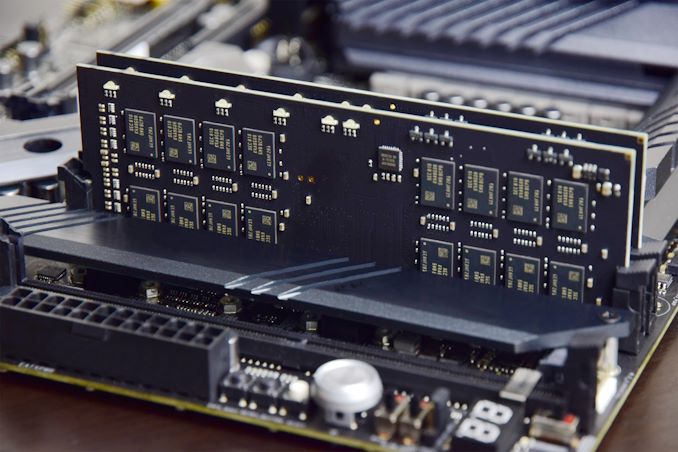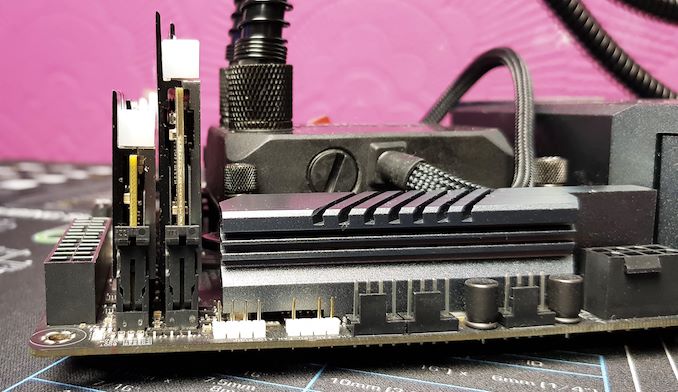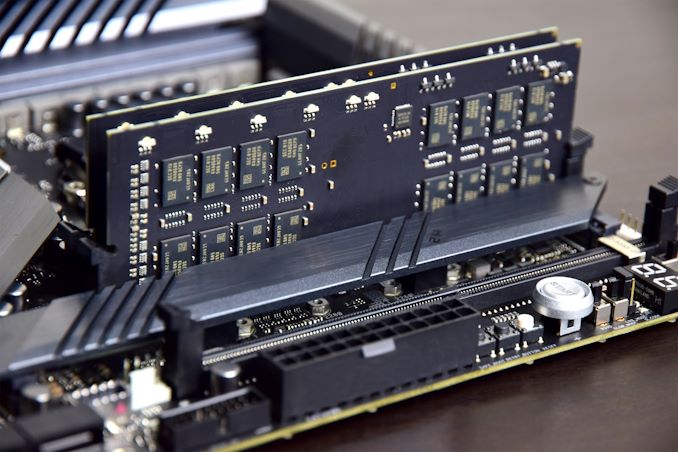Double Height DDR4: 32GB Modules from G.Skill and ZADAK Reviewed
by Ian Cutress & Gavin Bonshor on January 23, 2019 9:00 AM EST
Two memory module companies, G.Skill and ZADAK, have developed a new memory format with double capacity DDR4 memory. These new modules put the equivalent of two standard modules onto one PCB, making one memory module act like two. Both companies have introduced 2x32 GB kits. As a result, these memory modules are double the capacity over regular DDR4 memory, with the downside that they are also double the height. We have tested both of the available kits using this technique, both coming in at DDR4-3200: the G.Skill TridentZ RGB DC DDR4-3200 and the ZADAK Shield RGB DC DDR4-3200.
Double Height Memory?
One of the disadvantages of small form factor motherboards is that they only feature two memory slots. Most consumer DDR4 modules can have a maximum capacity of 16 GB per module, which for mini-ITX would mean a maximum capacity of 32 GB. For ATX motherboards, this usually means a maximum capacity of 64 GB. Users looking to build those small form factor systems have historically been capped to 32 GB - these new modules doubles that capacity to 64 GB.
There are currently three motherboards on the market validated for this new double height memory:
- ASUS ROG Maximus XI Apex (Z390)
- ASUS ROG Maximus XI Gene (Z390)
- ASUS ROG Strix Z390-I Gaming
These are all Z390 chipset motherboards, and thus applies to Intel's 8th Gen and 9th Gen processors. In this review we used an i7-8700K, and it didn't have any issues. We tested on some other motherboards from MSI and ASRock, however those systems did not post. It would appear that the memory has been developed in conjuction with concurrent validation with ASUS.

Left to Right: ZADAK Shield RGB DC, G.Skill TridentZ RGB DC,
G.Skill TridentZ RGB & Corsair Vengeance LPX
Each memory company is only offering a select number of kits, presumably due to the low catchment rate of the motherboards they are validated for, but also likely due to cost.
G.Skill is offering three different 'TridentZ RGB DC' memory kits, each 2x32 GB:
- G.Skill TridentZ RGB DC DDR4-3000 CL14
- G.Skill TridentZ RGB DC DDR4-3200 CL14
- G.Skill TridentZ RGB DC DDR4-3200 CL14 (looser secondary latencies)
ZADAK by contrast is offering five 'Shield RGB DC' memory kits, each 2x32 GB:
- ZADAK Shield RGB DC DDR4-2666 CL16
- ZADAK Shield RGB DC DDR4-3000 CL16
- ZADAK Shield RGB DC DDR4-3200 CL16
- ZADAK Shield RGB DC DDR4-3200 CL14
- ZADAK Shield RGB DC DDR4-3600 CL16
All of these kits (except ZADAK's DDR4-2666) have a rated voltage of 1.35 V. G.Skill's kits do not have associated MSRPs due to the way G.Skill operates, however ZADAK has shared that their memory kits will start from an MSRP of $800.
The benefit of dense(r) memory is thatmotherboards can double up on maximum capacity without needing four memory slots. All three motherboards listed, the Apex, Gene, and the Z390-I Gaming, only have two memory slots which makes them ideal targets, even though only one is mini-ITX and the other two could have had four memory slots in place. The reason why only these ASUS motherboards are supported at this time is due to the collaboration between the companies: ZADAK says the modules were 'co-developed', but failed to go into detail about who designed what. Nonetheless, these modules are ASUS exclusive for the time being.
Double Height: Cooler Selection
Using memory that is double the height of a normal module, certain other restrictions come into play: namely the CPU cooler being used has less room to exist.
The almost universal intention in this environment, unless a low powered CPU is used, is for a liquid cooler to be in play.
Under The Heatsinks
We'll go into more detail on the specific kits over the page, but both memory modules work in a similar fashion.
Using 8 Gb Samsung B-die chips, a normal 16 GB module would have 16 of them to make it up to capacity. For these modules, to reach 32 GB per module, there are 32 x 8 gigabit chips. These are split into two ranks of sixteen chips, and act as if there are two memory modules on the same channel. Modern mainstream processors support 'two DIMMs per channel', meaning two memory modules per channel, which is why we see motherboards for dual channel processors have a total of four slots. By putting two modules onto one PCB, only one slot is needed to hit 'two DIMMs per channel'.
One would assume the signalling would be different, however within the same channel, a normal set of memory modules would use the same traces and either (a) daisy chain, or (b) split near the end in order to support both simulateously. There are stability advantages to the (b) method, known as T-Topology, however it is often more difficult to do. Either way, because two memory modules on the same channel do not need separate motherboard traces, that is what makes these modules possible. There are some additional fine tuning elements to the system as well, as with all memory.
Ultimately any memory vendor's chips could have been used, but both G.Skill and ZADAK have gone with Samsung B-die, which are known for being good overclocking-focused memory. It likely also helps that the optimizations for one company's kit also helped with the second, as different ICs would have different requirements in the firmware.
Ultimately with this review, we want to answer the following questions:
- Is there any performance difference against normal 16GB modules, and
- How is the power draw affected?
The goal for both answers should be negative: we shouldn't expect any performance difference and no power difference. We also do some overclocking to see if they can be pushed harder even in this form factor.
Test Bed and Methodology
| Test Setup | |||
| Processor | Intel i7-8700K, 95W, $359 / 1ku 6 Cores, 12 Threads, 3.7 GHz (4.7 GHz Turbo) |
||
| Motherboard | ASUS ROG Strix Z390-I Gaming (BIOS Version 1003) | ||
| Cooling | Corsair H100i V2 | ||
| Power Supply | Thermaltake Toughpower Grand 1200W Gold PSU | ||
| Memory Tested | 2x32GB G.Skill TridentZ DC RGB DDR4-3200 CL14 (1.35 V) 2x32GB ZADAK Shield DC RGB DDR4-3200 CL14 (1.35 V) 2x16GB G.Skill TridentZ RGB DDR4-3200 CL14 (1.35 V) 2x16GB Corsair Vengeance LPX DDR4-2400 CL14 (1.2 V) 2x8GB TeamGroup Night Hawk RGB DDR4-3000 CL16 (1.35 V) |
||
| Video Card | ASUS GTX 980 STRIX (1178/1279 Boost) | ||
| Hard Drive | Crucial MX300 1TB | ||
| Case | Open Test Bed | ||
| Operating System | Windows 10 RS3 inc. Spectre/Meltdown Patches | ||
New Test Suite: Spectre and Meltdown Hardened
Our motherboard benchmarking suite which includes our short form CPU performance tests and gaming tests were selected in conjunction with our new 2019 bench suite. Our test bench OS has been updated with drivers, newer software and as with our CPU testing updates, also includes Spectre and Meltdown patches.
Pages In This Review
- Double Capacity, Double Height RAM [this page]
- G.Skill TridentZ RGB DC Overview: Analysis of the Board Components
- ZADAK Shield RGB DC Aura2 Overview : Looking that the non-hardware portion
- CPU Performance
- Gaming Performance
- Power Analysis
- Overclocking Performance
- Conclusion












50 Comments
View All Comments
Bp_968 - Thursday, January 24, 2019 - link
Or you could go with an AMD board and get to keep the ECC features enabled. :)KarlKastor - Friday, January 25, 2019 - link
How do u disable registered capability on a reg. DIMM? They are physically different to UDIMMs. Thats absolutely BS.You can run ECC UDIMM on every board, maybe without ECC working. But you will never run reg. DIMM on Hardware not supporting reg. DIMMs
nevcairiel - Wednesday, January 23, 2019 - link
You cannot use ECC registered RAM on consumer motherboards.CheapSushi - Thursday, January 24, 2019 - link
Yes you can. It depends on the CPU/BIOS.jordanclock - Wednesday, January 23, 2019 - link
The kind of systems that use ECC RAM aren't the kind of systems that are going to see any overclocking.alpha754293 - Thursday, January 24, 2019 - link
To the best of my knowledge, you can put ECC RDIMMs in consumer-grade systems where you have overclocking capabilities made apparent and available to you just as people have overclocked Xeons before.Just because you have RDIMMs doesn't necessarily mean that you have to only use them with a motherboard that supports and requires the use of RDIMMs. (In fact, many motherboards that recommend using RDIMMs will also run with UDIMMs, but usually with a lower installed capacity limit.)
Lord of the Bored - Wednesday, January 23, 2019 - link
Wouldn't two DIMMs on one card be a quad in-line memory module(QIMM)?Billy Tallis - Thursday, January 24, 2019 - link
No, because this approach doesn't make the memory bus any wider, it just stacks the memory deeper on the same bus than a normal DIMM would.Lord of the Bored - Thursday, January 24, 2019 - link
But both 8- and 32-bit SIMMs existed under the same name, so it clearly isn't bus width the name refers to.For what it is worth, I was wrong for a different reason. Research indicates that the D refers to rows of contacts. In a SIMM, the backside contacts were electrically the same as the frontside contacts, so there was only a single row. In a DIMM, they aren't, so you have dual contact rows. And since this still only has two rows of contacts...
Targon - Thursday, January 24, 2019 - link
The connection to the motherboard and support in the BIOS and memory controller are the key. More memory on the same memory channel will not boost performance, and will even degrade performance a bit due to needing to connect the additional memory on the same channel.DDR5(not to be confused with GDDR5) will help. Going to Gen-Z where the memory can connect to the Gen-Z bus might potentially help as well if done right, because you want that memory bus to be able to access more RAM at the same time, so latency will hopefully go down with the next generation of desktop memory.